
 Thank you, Dieter Endom and Jens Linder for sharing your wealth of culinary knowledge with us. Thanks also to all the mushroom experts, neighbors, relatives, and friends who have contributed to this book. Copyright 2012 by Ingrid and Pelle Holmberg and Norstedts, Stockholm
Thank you, Dieter Endom and Jens Linder for sharing your wealth of culinary knowledge with us. Thanks also to all the mushroom experts, neighbors, relatives, and friends who have contributed to this book. Copyright 2012 by Ingrid and Pelle Holmberg and Norstedts, Stockholm
English translation 2014, 2019 by Skyhorse Publishing
Design by Typerna/Seth Kapadia
Photography by Susanne Hallmann
First published by Norstedts, Sweden in 2012 as Svampkokboken by Ingrid and Pelle Holmberg. Published by agreement with Norstedts Agency. All Rights Reserved. No part of this book may be reproduced in any manner without the express written consent of the publisher, except in the case of brief excerpts in critical reviews or articles.
All inquiries should be addressed to Skyhorse Publishing, 307 West 36th Street, 11th Floor, New York, NY 10018. Skyhorse Publishing books may be purchased in bulk at special discounts for sales promotion, corporate gifts, fund-raising, or educational purposes. Special editions can also be created to specifications. For details, contact the Special Sales Department, Skyhorse Publishing, 307 West 36th Street, 11th Floor, New York, NY 10018 or Skyhorse and Skyhorse Publishing are registered trademarks of Skyhorse Publishing, Inc., a Delaware corporation. www.skyhorsepublishing.com 10 9 8 7 6 5 4 3 2 1 Library of Congress Cataloging-in-Publication Data is available on file. Print ISBN: 978-1-5107-5007-4 Ebook ISBN: 978-1-5107-5010-4 Cover design by Qualcom Printed in China CONTENTS  FOREWORD T en years ago we published the original Wild Mushroom Cookbook in Swedish together with the chef Dieter Endom.
FOREWORD T en years ago we published the original Wild Mushroom Cookbook in Swedish together with the chef Dieter Endom.
Dieter was the first chef to train as a mushroom expert, and it was fun as well educational to work with him. Dieter also contributed some of his best recipes to this book with some, so we would like to extend a big thank you to him! We hope our new mushroom cookbook will inspire you to experiment more when you cook with mushrooms, as there is a lot more you can do than just frying them or preparing them in creamy sauces. For almost forty years, we have together picked and prepared mushrooms of every variety. Pelle is a biologist and the author of roughly twenty books on nature. He has met tens of thousands of mushroom enthusiasts during his career and has even been involved in educating some of Swedens mushroom experts, several of whom have contributed to this book. Ingrid has participated in many excursions and exhibitions.
Sometimes, we give tasting sessions where we serve mushroom soup or something similar, and many people ask us for recipes and tips on how to prepare the mushrooms theyve picked. In our home, Pelle is the resident mushroom picker and over the years he has often set off before anyone else has woken up and returned just in time for breakfast with a few quarts of wild strawberries, gallons of blueberries, or multiple baskets filled with mushrooms. Thankfully, Ingrid loves cooking and happily prepares most of what Pelle brings home. Some of our favorite memories have come from working together to prepare the harvest from natures pantry, both from the woods and our garden. Mushrooms and berries have always been a welcome addition when we cookespecially when our four children were small and money was tight. Berries and mushrooms added something extra to our everyday lives and helped us stretch the household budget.
Now our children are grown, we are delighted to see that they, as well as their friends, enjoy picking mushrooms and berries. Every fall we make an improvised mushroom excursion with the kids and their families, friends, and their friends parents. We hope you will be inspired by our book to add some flavor to your own cooking with these wonderful mushrooms! INGRID and PELLE HOLMBERG  PICKING AND CARING FOR YOUR MUSHROOMS S urely not everyone picks as many mushrooms as we do. We dont merely have one basket filled with mushroomsone time Pelle came home with five banana boxes stuffed with Porcini! Thankfully the majority of the cleaning was done on site. The best weather to pick mushrooms is when its overcast but not raining. On sunny days, it can be hard to spot the mushrooms; in rainy weather, the mushrooms get wet and may fall apart easily.
PICKING AND CARING FOR YOUR MUSHROOMS S urely not everyone picks as many mushrooms as we do. We dont merely have one basket filled with mushroomsone time Pelle came home with five banana boxes stuffed with Porcini! Thankfully the majority of the cleaning was done on site. The best weather to pick mushrooms is when its overcast but not raining. On sunny days, it can be hard to spot the mushrooms; in rainy weather, the mushrooms get wet and may fall apart easily.
When picking mushrooms, you should have a decent and airy basket, a knife, and a brush. You can buy special mushroom knives with a brush on the handle, but sometimes this brush can be too soft; if you have one of these, cut off the ends of the bristles. Never put picked mushrooms in a plastic bag, as the bag quickly gets warm and humid, which means that the mushrooms can start to degrade and spoil. In an emergency, you can use a paper bag. Only pick mushrooms that you can identify with certainty. If you want to learn more, take a course.
At the very least, buy a good, up-to-date mushroom book that is designed for edible mushrooms in your local environment. There are books that may be written in your language but are about a different environment than your own. Many mushrooms have also been reclassified in the past few years. In older books, you may find that mushrooms that are no longer considered safe are classified as edible and even tasty. If you find different information in different books, always trust the information in the latest edition. Picking and removing dirt When it comes to cleaning the mushrooms, doing the major work on site will make it so much easier to clean them when you get home.
Remember never to pick more than you are able to clean and care for, preferably on the same day as they are picked. Pick up the whole mushroom, including the base of the stipe so that you are able to see all the important characteristics needed to identify the mushroom. Smell the mushroom and make sure it smells the way it ought to. Once you are sure of the mushrooms identity, cut off the portion of the base of the stipe that is covered in dirt. If the mushroom is large, cut it in half to see if it has been attacked by maggots. Throw away any mushroom that is too infested.
If it is not too badly infested, remove only those parts that have been affected. Any tubes that are attached can be left. Remove any pine needles and dirt with a brush before placing the mushroom in a basket. If you have found a mushroom that you need to take home in order to identify it further, place it in a separate part of the basket. It is always worth cutting up a milk carton or bringing a plastic tub to place these mushrooms in to avoid mixing them in with the edible mushrooms. Upon your return, you will have a basket filled with clean, maggot-free mushrooms, which will be quite helpful once you sit down to start the finer cleaning.
Cleaning Place the mushrooms on a table and sort them into piles by mushroom type. Start with cleaning the Russulas and Boletales, which are the most sensitive. Chanterelles, Trumpet Chanterelles, Black Trumpets, and Yellow Foot can survive for several days if they are placed in the fridge and are well ventilated. Remove the slimy skin off the caps of mushrooms such as the Slippery Jack and the Slimy Spike Cap. Needles and debris attached to the caps can be removed with the rough side of a damp kitchen sponge or a scouring pad. Mushrooms that need to be precooked or blanched can be rinsed if they are dirty.
Next page
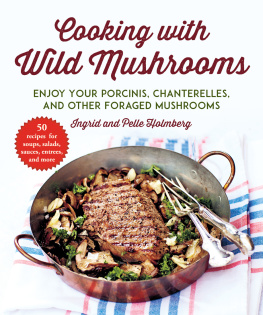
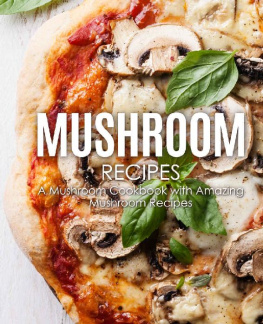


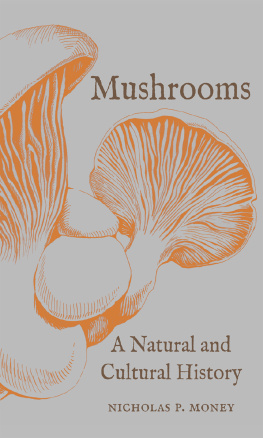
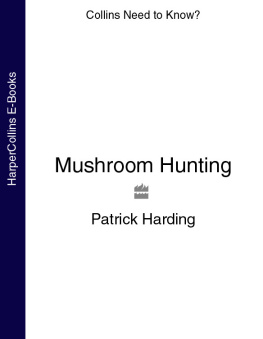
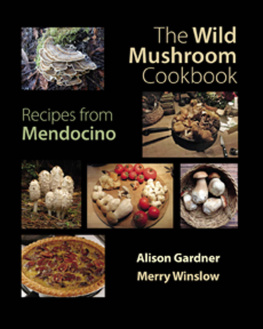
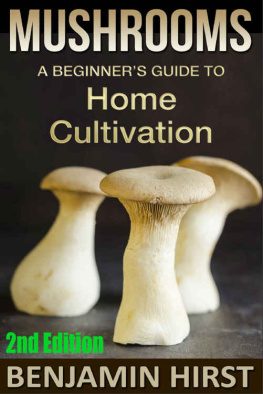
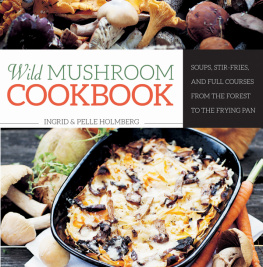
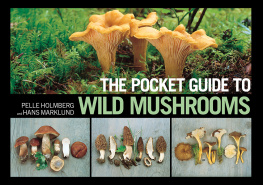
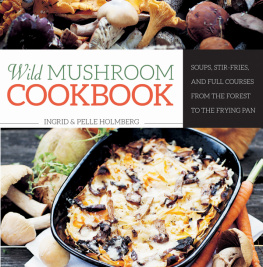

 Thank you, Dieter Endom and Jens Linder for sharing your wealth of culinary knowledge with us. Thanks also to all the mushroom experts, neighbors, relatives, and friends who have contributed to this book. Copyright 2012 by Ingrid and Pelle Holmberg and Norstedts, Stockholm
Thank you, Dieter Endom and Jens Linder for sharing your wealth of culinary knowledge with us. Thanks also to all the mushroom experts, neighbors, relatives, and friends who have contributed to this book. Copyright 2012 by Ingrid and Pelle Holmberg and Norstedts, Stockholm FOREWORD T en years ago we published the original Wild Mushroom Cookbook in Swedish together with the chef Dieter Endom.
FOREWORD T en years ago we published the original Wild Mushroom Cookbook in Swedish together with the chef Dieter Endom. PICKING AND CARING FOR YOUR MUSHROOMS S urely not everyone picks as many mushrooms as we do. We dont merely have one basket filled with mushroomsone time Pelle came home with five banana boxes stuffed with Porcini! Thankfully the majority of the cleaning was done on site. The best weather to pick mushrooms is when its overcast but not raining. On sunny days, it can be hard to spot the mushrooms; in rainy weather, the mushrooms get wet and may fall apart easily.
PICKING AND CARING FOR YOUR MUSHROOMS S urely not everyone picks as many mushrooms as we do. We dont merely have one basket filled with mushroomsone time Pelle came home with five banana boxes stuffed with Porcini! Thankfully the majority of the cleaning was done on site. The best weather to pick mushrooms is when its overcast but not raining. On sunny days, it can be hard to spot the mushrooms; in rainy weather, the mushrooms get wet and may fall apart easily.